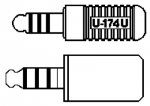Aircraft Intercom
While it is possible to connect to Aircraft Intercom systems, the quality is at communications level rather than broadcast, though it may be adequate for short items and can give a useful “atmos”. Aside from the issues of obtaining the correct connector you MUST obtain permission from the pilot on each occasion before connecting location mixers or anything else to the aircraft. You MUST also check all systems on the ground and not attempt to re-cable in flight.
Transformer isolation (internal to the mixer or an external unit) is strongly recommended to avoid affecting DC conditions in aircraft circuits.
Aircraft intercoms are always band-limited and use AGC and noise gating. In noisy environments this can be an advantage – the LF content of engine roar and breath noise is heavily reduced and levels are kept constant irrespective of shouting. In military or other ‘services’ aircraft pilot/ground radio (‘RT’) and internal chat comms (commonly termed ICS or Interphone) are often kept on separate circuits. Civilian aircraft normally have everything mixed together. In light aircraft there may only be one set of volume controls for all occupants whereas larger commercial aircraft will typically have separate sets of audio controls for each flight deck position effectively enabling each crew member to have their own ‘mix’ of radios and intercom. Be aware that comms mic feeds may have a DC bias on one leg, and are usually marked “carbon mic” (even though the mics are more likely to be amplified electret, or amplified dynamic). Unpowered “dynamic” mics are widely used too. Dynamic microphones in military aircraft may have very low output voltage and an impedance commonly as low as 5 ohms.
The biggest problem with a direct connection to the intercom is likely to be getting the right connector with the correct wiring. If at all possible contact the pilot beforehand to ask what intercom connector and pinout the aircraft has. You may have to contact the aircraft’s maintenance department as well; they may have a suitable lead you can borrow. A photograph of the connector may be the most helpful identification – aircraft and broadcast terminology do not always match, and NATO and Nexus (sometimes known as “US Nato”) connectors are tricky to distinguish.
Nexus U-174/U plug at the top.
UK NATO at the bottom.
The principle differences are:
The Nexus has a rounded tip.
The NATO has some insulation on the shaft adjacent to the body.
The handle of the Nexus is 12.7 mm dia.
The handle of the NATO is over 20 mm dia.
Other terms that may need explaining in an aircraft context are “Vox” – noise-gate in audio-speak – and “Hot mic” – “Open mic” in broadcast terms, as opposed to PTT (press to talk).
Failing a direct connection a personal mic placed between the ear muffs of a spare headset may produce acceptable results. If you have to use tape to keep the muffs together, remember to remove any residue afterwards.
XLR 3 sockets are sometimes used in aircraft to provide a source of DC power, e.g. for Active Noise Reduction headsets, they are unlikely to have any audio on them, and pin 1 may not even be 0V.
This pdf document Aircraft Intercom Pinouts gives information and brief connector information.

